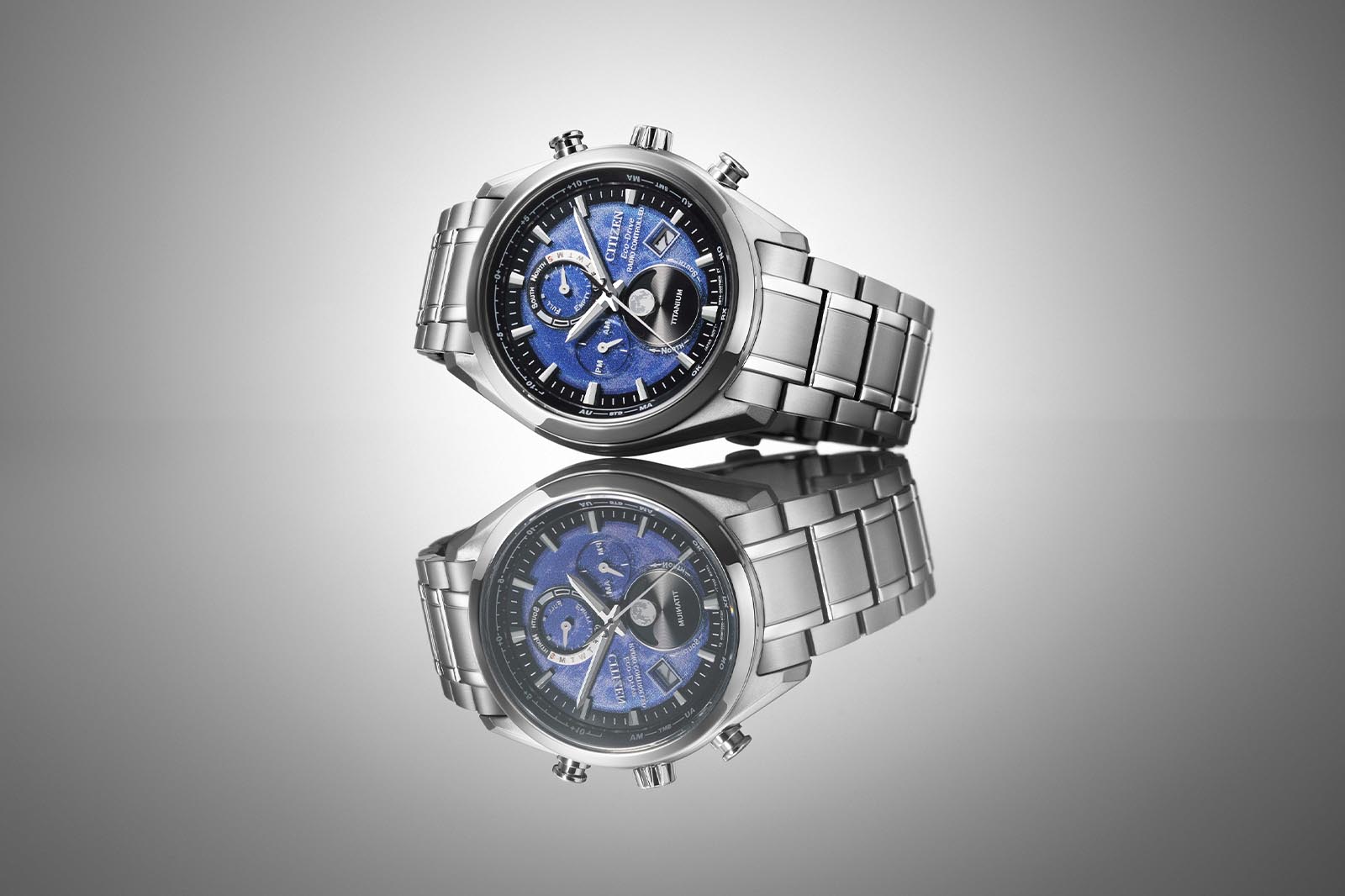
The new ‘Tsuki-yomi’ combines Eco-Drive Movement, Radio Controlled Atomic Accuracy and a Radio Controlled Moonphase
It’s impossible to talk about accessible Japanese watchmaking without mentioning Citizen. A large potion of their success can be contributed to ability to continuously innovate with perhaps the best example of this being ever evolving Eco-Drive movement. The ever-accessible watchmaker have been one of the biggest players in the industry for over a century, and while they play in a very different ballpark to the finest Swiss artisans, they’ve had arguably more of an impact on timekeeping as a whole.
That’s because Citizen’s focus isn’t how finely-tuned a balance wheel can be or how exquisitely guilloched a dial is. In line with the greatest Japanese tech firms, their entire raison d’etre is innovation. Indeed, the history of Citizen is a history of horological innovation, from initial forays into quartz to the use of titanium in watchmaking. However, if there’s one thing that Citizen as a brand is inextricably linked with, something that over the past few decades has come to define then, it’s the Eco-Drive movement.
1974 Prototype, the first light-powered watch concept
The concept behind the Eco-Drive movement is simple, even if its mechanics are not. It’s a movement powered by light. That doesn’t just mean the sun, but even dim light, meaning that if you can read it, it’s charging. That’s achieved with some seriously small solar cells that are placed either underneath a translucent dial or around the edge of the face, depending on the model. This energy is then used to run the watch, with excess being stored on a lithium-ion battery.
While the sustainability flavour of the Eco-Drive name fits in nicely with the current ecological climate (change), it actually dates back to when murmurs of oil issues were still new – specifically, the early 70s. This is when quartz watches were still shiny and new, before the nascent technology took down half the Swiss watch industry. The initial idea was to eliminate batteries, but maintain electrical accuracy with the feel of a mechanical watch. After a 1974 concept, the Crystron Solar Cell, the world’s first light-powered analogue watch was released.
Crystron Solar Cell, 1976
It was an instant success for Citizen. Other brands were already touting the benefits of quartz over mechanical – accuracy, reliability, ease of servicing, the list goes on – but the idea of getting all that without ever needing to change the battery was easy to cling onto. The fact that the watches were sleek in the necessarily modern, semi-futuristic way, was all the better.
Like with all technology, the Eco-Drive only got better with time and by 1995 it could manage six months running time on a full charge. This is, mind you, the running time in complete darkness without any light sources so much as peeking through to the solar cells, a level of energy management that Citizen has maintained in the modern collection. Like I said, it’s one of the single most important elements that the Japanese watchmaker has ever built and one of the cornerstones of their very particular take on watchmaking. But, it has to be said, it’s not their only one. While the Eco-Drive emphasises autonomy above everything else, atomic movements are all about accuracy.
Citizen’s First Radio Controlled Watch 1993
An atomic clock is, as the name hints at, a timekeeper that uses atomic frequencies to tell the time. The more times a balance spring oscillates an hour, the more accurate the watch; an atomic clock takes that concept and instead replaces it with the frequency of microwave electromagnetic radiation. Needless to say, there aren’t many atomic clocks in the world, generally in national metrology labs, and definitely not enough to try putting one in a watch.
Instead, Citizen’s atomic movements use these clocks as reference points, using radio signals to constantly sync to their one second per 100,000 years accuracy. Put this together with the Eco-Drive and you have a watch that will never stop giving you the most accurate time – provided you don’t bury it in a lead coffin for six months. Throw in a moon phase and you have the new Tsuki-yomi A-T.
‘Tsuki-yomi’ Radio-Controlled Moonphase
I won’t harp on that this is the first light-powered, atomic timekeeping moon phase movement; it’s one of those niche ‘firsts’ that doesn’t really mean anything. But the watch is a fantastic encapsulation of everything Citizen stands for. It has atomically-synced timekeeping, kept powered by light, encased in Super Titanium (another bit of proprietary Citizen know-how) and is dedicated to an ancient Japanese god of the moon.
If you were to try and define the brand, just show someone this. It’s also worth noting that, as the moon phase is updated via multi-band radio transmitters, it never needs setting – and will even switch when you cross from one hemisphere to the other.
‘Tsuyosa’
Pieces like the recent, incredibly successful Tsuyosa are a big part of the conversation when it comes to Citizen, cool, accessible watches. Half the guys in the Oracle Time office have one colour or another. But for me, what defines the brand is their unique approach to timekeeping itself and their novel technologies that drive it – technologies like Eco-Drive.
More details at Citizen.
Oracle Time